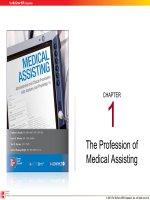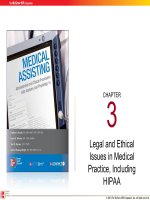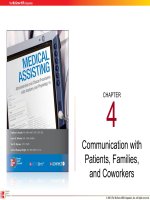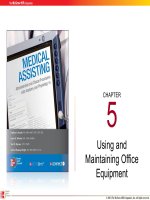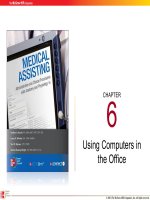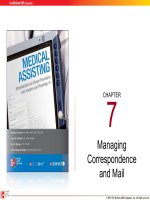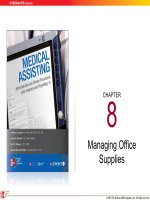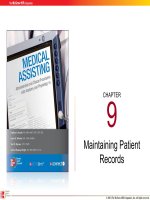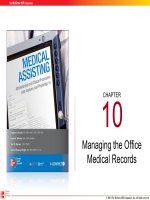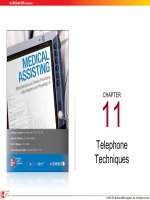Lecture Medical assisting: Administrative and clinical procedures with anatomy and physiology (4e) – Chapter 7
Bạn đang xem bản rút gọn của tài liệu. Xem và tải ngay bản đầy đủ của tài liệu tại đây (911.74 KB, 62 trang )
CHAPTER
7
Managing
Correspondence
and Mail
© 2011 T he McGraw -Hill Com panie s, Inc. A ll rights reserv ed.
7-2
Learning Outcomes
7.1 List the supplies necessary for creating and
mailing professional-looking
correspondence.
7.2 Identify the types of correspondence used in
medical office communications.
7.3 Describe the parts of a letter and the
different letter and punctuation styles.
7.4 Compose a business letter.
© 2011 T he McGraw -Hill Com panie s, Inc. A ll rights reserv ed.
7-3
Learning Outcomes (cont.)
7.5 Explain the tasks involved in editing and
proofreading.
7.6 Describe the process of handling incoming
and outgoing mail.
7.7 Compare and contrast the services provided
by the U.S. Postal Service and other delivery
services.
© 2011 T he McGraw -Hill Com panie s, Inc. A ll rights reserv ed.
7-4
Introduction
• Written materials demonstrate
ability to
– Communicate
– Conduct business
• Professional image is conveyed in written
correspondence
• Written documents = legal records
© 2011 T he McGraw -Hill Com panie s, Inc. A ll rights reserv ed.
7-5
Correspondence and Professionalism
Learning to
Create
Receive
Send
correspondence properly ensures positive,
effective communication between your office and
others.
© 2011 T he McGraw -Hill Com panie s, Inc. A ll rights reserv ed.
7-6
Choosing Correspondence Supplies
Letterhead paper
Envelopes
Supplies
Supplies
Labels
Statements
Invoices
© 2011 T he McGraw -Hill Com panie s, Inc. A ll rights reserv ed.
7-7
Choosing Correspondence Supplies
Letterhead
– Formal business stationary
– Doctor’s or office’s name,
address, phone number
printed at the top
– Correspondence with
(cont.)
Medical Practice, Inc.
111 One Dr.
Any, St. 11111
111-111-1111
• Patients
• Colleagues
• Vendors
© 2011 T he McGraw -Hill Com panie s, Inc. A ll rights reserv ed.
7-8
Choosing Correspondence Supplies (cont.)
Letterhead
– Cotton fiber bond
Medical Practice, Inc.
111 One Dr.
Any, St. 11111
111-111-1111
• More expensive than other
types of paper (sulfite bond)
• Watermark
– Sizes
• Standard or letter size – 8½ x 11 inches
• Legal size – 8½ x 14 inches
© 2011 T he McGraw -Hill Com panie s, Inc. A ll rights reserv ed.
7-9
Choosing Correspondence Supplies (cont.)
Envelopes
– Should match letterhead
– Types of envelopes
•
•
•
•
Correspondence or business – No. 10
Invoices or statements – No. 6 to No. 10
Payment-return envelopes
Tan Kraft or clasp envelopes – large, bulky
documents
• Padded envelopes – send items that may be
damaged during mail handling
• Data mailers
© 2011 T he McGraw -Hill Com panie s, Inc. A ll rights reserv ed.
7-10
Choosing Correspondence Supplies (cont.)
Labels
– Printed, computerized address labels can save a large
amount of time
Invoices and statements
–
–
–
–
–
Preprinted invoices
Preprinted statements
Computer-generated invoices and statements
Superbills
Data mailers
© 2011 T he McGraw -Hill Com panie s, Inc. A ll rights reserv ed.
7-11
Apply Your Knowledge
What three things do written materials of a medical
office convey or demonstrate?
ANSWER: Written materials convey the ability of the
medical office staff to communicate and to conduct
business, as well as demonstrate a professional
image that reflects on the entire office staff.
© 2011 T he McGraw -Hill Com panie s, Inc. A ll rights reserv ed.
7-12
Written Correspondence
• Form of communication
• Purpose - to explain, clarify, or provide
information
• Types
–
–
–
–
–
–
Referrals
Scheduling
Patient reports
Patient education
Insurance/billing information
Cover or form letters
© 2011 T he McGraw -Hill Com panie s, Inc. A ll rights reserv ed.
7-13
Parts of a Business Letter
• Letterhead
• Dateline
– Month, day, and year
– Begins 3 lines below letterhead on line 15
• Inside address
– Includes information needed for correct
delivery
– Two to four spaces below dateline
© 2011 T he McGraw -Hill Com panie s, Inc. A ll rights reserv ed.
7-14
Parts of a Business Letter (cont.)
• Attention line
– Used when letter is sent to specific person in a company
• Salutation
– Written greeting such as “Dear”
– May use business title or department if name is not known
– Second line below inside address
© 2011 T he McGraw -Hill Com panie s, Inc. A ll rights reserv ed.
7-15
Parts of a Business Letter (cont.)
• Subject line
– Used to bring attention to subject (optional)
– Second line below salutation
• Body
– Begins two lines below salutation or subject
line
– Single-spaced within a paragraph
– Double-spaced between paragraphs
© 2011 T he McGraw -Hill Com panie s, Inc. A ll rights reserv ed.
7-16
Parts of a Business Letter (cont.)
• Complimentary closing
– Placed two lines below body
– “Sincerely” is commonly used
• Signature block
– Places writer’s name on first line and business title on
second line
– Three to four lines below complimentary closing
© 2011 T he McGraw -Hill Com panie s, Inc. A ll rights reserv ed.
7-17
Parts of a Business Letter (cont.)
• Identification line
– Letter writer’s initials and the typist’s initials
(KB/SF or KB:SF)
– Two lines below the signature block
• Notations
– May be abbreviated as Encl, Enc, or Encs
– Copy notation (c:) appears after the enclosure
notation
– Number of enclosures and copy recipients
– One to two lines below signature block or
identification line
© 2011 T he McGraw -Hill Com panie s, Inc. A ll rights reserv ed.
7-18
Written Correspondence (cont.)
Punctuation Styles
Open
Mixed
© 2011 T he McGraw -Hill Com panie s, Inc. A ll rights reserv ed.
7-19
Punctuation Styles
• Open punctuation uses no punctuation after these
items in a letter
– The word Attention in the attention line
– The salutation
– The complimentary closing
– The signature block
– The enclosure and copy notations
© 2011 T he McGraw -Hill Com panie s, Inc. A ll rights reserv ed.
7-20
Punctuation Styles (cont.)
• Mixed Punctuation includes the following:
– Colon after Attention in the attention line
– Colon after the salutation
– Comma after the complimentary closing
– Colon or period after the enclosure notation
– Colon after the copy notation
© 2011 T he McGraw -Hill Com panie s, Inc. A ll rights reserv ed.
7-21
Letter Format
Margins: One inch on the left and right for
8 ½-inch wide paper
Letter should be centered on the page
Single-space body of letter and double-space between
paragraphs
Short sentences with no more than 20 words on an
average
© 2011 T he McGraw -Hill Com panie s, Inc. A ll rights reserv ed.
7-22
Letter Format (cont.)
Have at least two or three sentences per paragraph
Divide paragraphs longer than 10 lines into shorter
paragraphs
For multipage letters, use letterhead for first page only
© 2011 T he McGraw -Hill Com panie s, Inc. A ll rights reserv ed.
7-23
Written Correspondence (cont.)
Letter Style
Description
Full-Block
• Lines are typed flush left
• No indented paragraphs
• Most commonly used in medical office
ModifiedBlock
• Dateline, complimentary closing, signature
block, and notations are aligned at the
center of the page or to the right
• Traditional, balanced appearance
© 2011 T he McGraw -Hill Com panie s, Inc. A ll rights reserv ed.
7-24
Written Correspondence (cont.)
Letter Style
Description
Modified-Block
with Indented
Paragraphs
• Paragraphs are indented ½ inch
Simplified
•
•
•
•
•
Modification of full-block style
Most modern letter style
No salutation, courtesy title, or closing
Has a subject line in all capital letters
Too informal for medical office
© 2011 T he McGraw -Hill Com panie s, Inc. A ll rights reserv ed.
7-25
Apply Your Knowledge
What should the medical assistant do if a mailing is
to be sent to an organization to request x-ray films,
but no specific name or title is given to address it to?
Which of the following would you use?
ANSWER:
A. To Whom It May Concern
B. Attention: To Whom It May Concern
C. Dear Sir/Madam
D. Dear Radiology Department
© 2011 T he McGraw -Hill Com panie s, Inc. A ll rights reserv ed.
